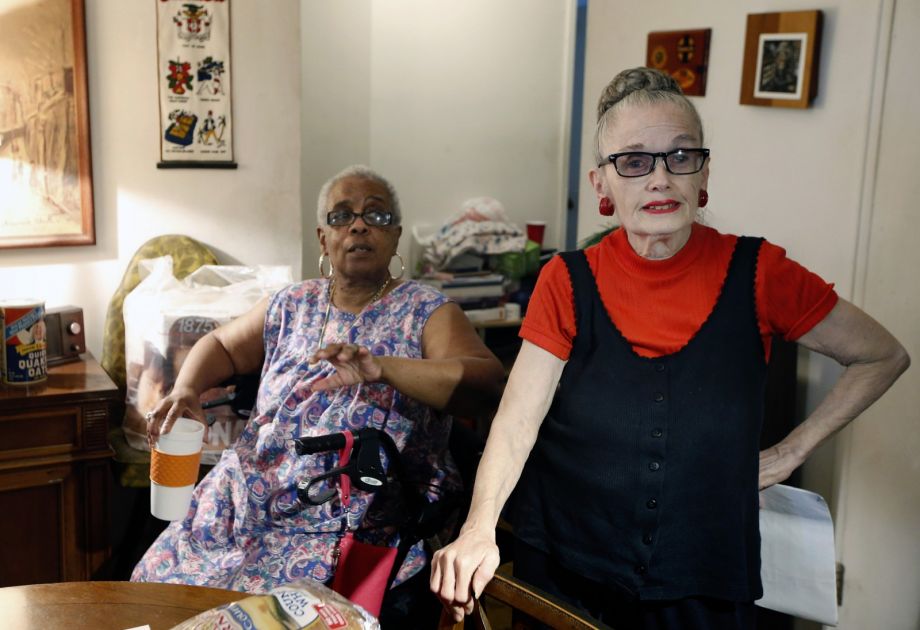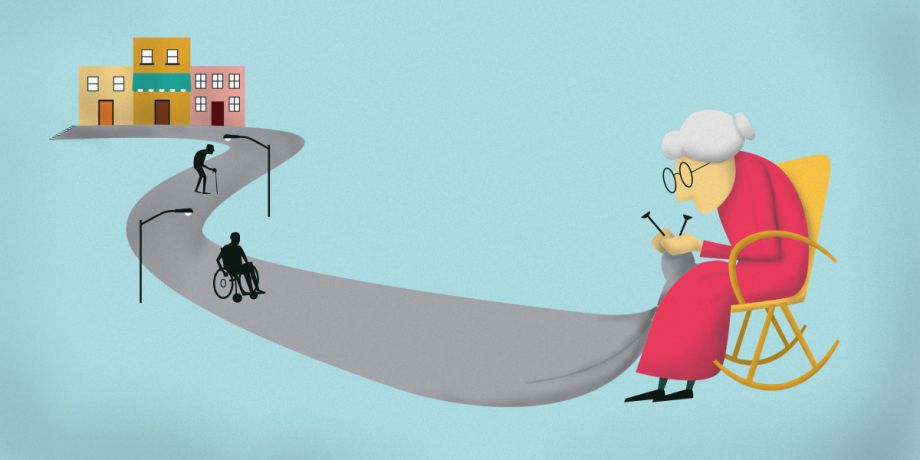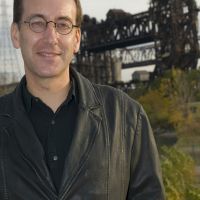Are You A Vanguard? Applications Now Open
This is your first of three free stories this month. Become a free or sustaining member to read unlimited articles, webinars and ebooks.
Become A MemberProximity to toilet paper.
That’s how Zachary Benedict, a partner at MKM Architecture + Design in Fort Wayne, Indiana, measures a neighborhood’s walkability, and therefore, its suitability to the senior citizens he believes will be the salvation of Indiana’s small towns and cities.
“What neighborhood do you know has toilet paper in walking distance?” Benedict asked at TEDxFortWayne in 2012, waving his arm. “You NEED that to live.” It’s something many of his peer architects rarely consider.
But Benedict is convinced that will soon have to change. Over the next 15 years, 10,000 Americans will turn 65 every single day. By 2030, 20 percent of the U.S. will be senior citizens, compared to 13 percent today. Cities will have to adapt, not just to a growing population of elderly, but to the baby boomers’ idea of what it means to be elderly, which is already proving to be different than previous generations’ ideas. Forget about bringing Bob Dylan to the nursing home — AARP has found in study after study that baby boomers want many of the same things as millennials. They want to be mobile and social, with easy access to bus stops, grocery stores, parks, pharmacies and hospitals. It’s not just a matter of taste, but a practical necessity. The average senior outlives his or her driver’s license by six to 10 years, said Rodney Harrell, director of livable communities for AARP. Those who can afford it are moving into cities while those who stay put in the suburbs are demanding their neighborhoods urbanize — a demand Benedict believes such suburbs ignore at their peril.
“I can’t rectify my brain how they survive without dealing with this issue,” he said.
Nowhere is this work more critical than in Indiana, where the population is aging faster than the rest of the country. Between now and 2040, Indiana’s population will grow by 15 percent. The state’s population of residents 65 and older will grow by 90 percent. Those converging demographic trends put Indiana squarely in the crosshairs of one of the largest migratory shifts in American history — one that the state needs to get out ahead of now.
“Brain-drain people are moving to knowledge centers. Seniors are moving to places they can age in place,” Benedict said. “We need to understand that, because it matters to the survival of our communities that you can compete in a migratory shift like that.”
Although it has a big city at its center, Indiana is the quintessential small-town state, a land of county seats whose skylines are defined by limestone courthouses, and whose social calendars are filled with pig roasts and classic car rallies. (John Mellencamp’s song “Small Town” was inspired by his hometown of Seymour, Indiana.) Benedict grew up in Kendallville, pop. 10,000, and studied architecture at Ball State, in Muncie. After college, he got a job at MKM, and found himself working with a retirement community that wanted to build a $20 million “internal Main Street” for its campus on the outskirts of a small town. Planners imagined an ice cream parlor, a movie theater and a beauty salon all within the private community.
“We saw a rendering of it, and it was like Main Street Disneyland, but literally two to three miles away from an actual historic downtown that had struggling vendors and mom-and-pop shops,” he recalled. “Twenty million dollars in a small Indiana town? That’d be more of a development package than the community’s seen forever.”
Benedict was struck with an insight. Instead of bringing Main Street to retirement communities, why not bring retirement communities to Main Street? Instead of lamenting Indiana’s overabundance of seniors as mortal proof of the state’s brain drain, why not look at them as an opportunity to bring life back to the small towns and cities that many of them abandoned when they moved to the suburbs to raise their children?

Zachary Benedict can’t fathom a future for suburbs and small cities that do not adapt to meet needs of aging baby boomers. (photo credit: Zachary Benedict)
At his TEDxFortWayne talk, which was titled “Synaptic Networks,” Benedict flashed a slide of a classic Midwestern small town, with two- and three-story buildings from the era of William McKinley where “we all went to this central area for stuff: milk, eggs, hammers, gossip, camaraderie.” Then he clicked to a slide of a highway interchange, a map of nerves cast in concrete and asphalt.
“We traded this for this,” he remarked. “But 80 million people in this country are too young, too old, or too poor to drive. They don’t see this as a viaduct. They see this as a Berlin Wall, an impediment. We have to understand what these marginalized populations are, and what they need. If we can raise the quality of life for those individuals, we raise the quality of life for everyone.”
Atlanta urban planner M. Scott Ball is the author of Livable Communities for Aging Populations: Urban Design for Longevity. He and Benedict, along with colleague Philip Stafford, the sixtysomething director of Indiana University’s Center on Aging and Community, are part of growing cohort of urbanists thinking about how communities can prepare for the coming “silver tsunami,” as they call the demographic shift.
Ball ranks New York City, Atlanta and the state of Indiana among the leaders in the nascent movement to age-proof cities, which he sees as an “opportunity to rethink American urban form.” The specifics of how to do this look different in every community.

Carolyn Allen, left, a 69-year-old widow who has suffered two strokes, is shown with roommate Marcia Rosenfeld, who owns the apartment in Brooklyn, New York, where Allen lives. The two women are roommates thanks to a home-sharing program run by the New York Foundation for Senior Citizens, a nonprofit agency. (AP Photo/Kathy Willens)
In 1992, Ball’s hometown of Atlanta passed the nation’s first “visitability ordinance,” mandating that certain new single-family homes have 32-inch wide doors, a zero-step entrance and first-floor bathroom walls reinforced to support grab bars. The regulations were designed to aid the physically handicapped, but have since been copied by areas with large senior populations, including St. Petersburg, Florida and Pima County, Arizona. Meanwhile in New York City, there is a significant senior population that can’t afford to leave their rent-controlled apartments for new senior-friendly housing, so city officials designated three neighborhoods with large senior populations — East Harlem, the Upper West Side and Bedford-Stuyvesant — as “Aging Improvement Districts,” setting aside senior hours at a public pool, providing chairs to neighborhood businesses and making public-housing laundromats more accessible. Other cities such as Seattle are changing zoning codes to allow smaller “mother-in-law cottages” to pop up in the yards of single-family homes, creating an affordable option for aging relatives. Back in Indiana, solutions have been found in direct assistance grants and still other interventions from City Hall.
Huntington, Indiana is best known as the hometown of former Vice President Dan Quayle, the first baby boomer to hold national office. Quayle is now a senior citizen, but he moved to Arizona long ago. The city he left behind has struggled economically, with a stagnant population, an 11 percent unemployment rate, and a below-average per capita income. During the recession, Huntington was hit with more than 200 foreclosures, and the supermarket serving the city’s downtown closed its doors.
In 2012, the city began its rebound. Seniors factored heavily into the plan. Through a $662,000 Communities for a Lifetime grant from the state, Huntington offered help to elderly residents who didn’t want to move to nursing homes or retirement communities outside of the city’s borders. For low-income homeowners over 55 years old, the city offered grants to retrofit houses with the walk-in showers, porch ramps and wheelchair-sized doors they would need once aging made daily life more difficult. Benedict was hired to write a prospectus for a “Lifetime Community District.” Working with a social service agency, he interviewed seniors about their needs, and conducted a streetscape analysis that recommended replacing old brick sidewalks with concrete and constructing a trail for walking and biking. It also laid out a plan for reconfiguring an intimidating five-way intersection that’s an obstacle to pedestrians. The goal is to link the neighborhood with Huntington’s business district, which can be reached on foot in 10 minutes. Benedict’s toilet paper analogy sold the city on the vision.
“It’s so simple, it’s brilliant,” said Bryn Keplinger, Huntington’s director of community development and redevelopment. “That is a staple of life.”

Lee and Barb Trainer are two of the Huntington newcomers to benefit from the strategy. The couple moved to Huntington after raising a family in the nearby countryside. Lee, 67, has been through sextuple-bypass heart surgery, and can no longer walk up a flight of stairs without becoming winded. Barb, 63, suffers from Parkinson’s disease and limps after a knee replacement.
“Too big of a yard to take care of, and the country roads, that winter, those drifts, we wouldn’t have made it,” Barb says. “We love the country, but when you get older, you have to move into town. It’s a lot easier to get around, and if I have to walk, I can walk to the grocery store.”
The Trainers were fortunate to qualify for a Communities for a Lifetime grant and will soon install a walk-in shower to replace a bathtub whose low wall has become a challenge to step over. They’re also getting double-pane windows to reduce their heating bills, a new back door and a re-shingled roof. Outside the house, the old brick sidewalk was torn up and replaced with easier-to-manage cement, and the street corners were smoothed out with curb cuts.
“That was real important, because we had a brick sidewalk,” Barb says. “We had grass growing in it, and it dipped. I couldn’t shovel it if I wanted to.”
Both believe it will not only extend the life of their house, it will extend their lives in the house.
“Hopefully, this will be our last place we live,” Lee says.
“I’m not planning on moving,” Barb agrees.
Across town from the Trainer’s residential neighborhood, downtown Huntington has become a magnet for senior citizens. The Hotel La Fontaine has housed senior apartments for decades. But four years ago, a 35-unit building called Central Living opened in a converted elementary school — an apt symbol of the baby boom’s progression and the demographic shift Indiana is undergoing. Now developers are about to break ground on another apartment building for seniors, Park Lofts. The 60-unit development will replace a shuttered YMCA and the old offices of Our Sunday Visitor, a Catholic publication. Two new shops are also catering to the over-65 crowd: Antiqology, an antique store with a soda fountain and a penny-candy counter, and the New Huntington Theatre, a converted movie house that is currently mounting a dinner theater production of “The Sound of Music.”
Over the next 15 years, 10,000 Americans will turn 65 every single day
With the senior population rapidly growing, Huntington’s mayor, Brooks Fetters, recently began holding periodic Downtown Roll-Arounds, during which officials try to navigate the streets in walkers and wheelchairs. After some tough rides at the last roll-around, the city installed a new ramp at the parking lot where the farmers’ market is held, so wheelchair users no longer have to navigate the street. Local officials are also discussing legalizing golf carts for use on city streets.
The Mayor is thrilled to see the new life downtown — and not at all surprised to see it being generated from baby boomers.
“Boomers are controllers of their destiny,” said Fetters, a former funeral director. “They don’t want anyone telling them what to do. They’ve always been wired that way. They’re used to options. They’re used to customization. They’re going to believe they truly can control old age and death. The difference between the American and European approach to death — Americans think death is optional. Baby boomers are the same way.”
Two days before his 65th birthday, Philip Stafford took a walk along the B Line, a stretch of old railbed that’s been converted into a walking and biking path running through the heart of Bloomington, past the Indiana University campus and the courthouse square. Stafford was participating in a walk audit of his hometown, part of an active living workshop whose goal was to make Bloomington a city where anyone can get along
without a car.
Stafford saw the asphalt path as the main drag for a senior living center he envisions just north of downtown Bloomington. According to a site plan for a Bloomington Lifetime Community District (drawn up by Benedict’s MKM Architecture + Design), it would include an apartment building, with retail and offices on the lower floor, a senior care campus, and a community garden. There’s already a grocery store across the street, and a bus stop a block away.“Twenty percent of people over 65 don’t drive,” Stafford explained.

Stafford has spent his entire career thinking about the problems of the elderly. A native of Hobart, in northwestern Indiana’s Calumet Region, he came to Bloomington at 22 to earn a master’s degree in sociology. Originally he intended to study Amazonia, but ended up writing his thesis on growing old in the small town of Bloomfield, 10 miles southwest of Bloomington. After that, he worked with older adults at a hospital and a community mental health center. Fifteen years ago, he joined the faculty of Indiana University, where he directs the Center on Aging and Community, which conducts research on how the elderly can remain independent and engaged in their surroundings. Stafford also authored the book Elderburbia: Aging With a Sense of Place in America. In it, he declared that “the old Sun City, gated-community model of old age may be on the way out,” replaced by the “aging in community” movement, in which seniors remain where they’ve lived their entire lives, or retire to multi-generational environments.
“I’ve always been interested in this stuff,” he said. “When I was in junior high school, I used to go around with my tape recorder to older people in the neighborhood, because I was interested in their stories. I had an older woman across the street. I used to sit on the porch swing with her. Her name was Mrs. Culberston, and she was a direct descendant of Daniel Boone. I thought, ‘This is really cool.’”
As director of the Center on Aging and Community, Stafford came up with the concept for Indiana’s Communities for a Lifetime program. He first pitched it to his local state senator as a bill establishing a state commission to designate and support elder-friendly communities. The bill never passed, but the idea was picked up by the state’s Housing and Community Development Authority — which used Stafford’s research to develop priorities for the program, and hired him to work with the winning communities: Huntington, Linton and Valparaiso. (Stafford recommended MKM Architecture + Design to Huntington. Linton received funds to make its arts center compliant with the Americans With Disabilities Act, and install an aquatic lift at its community swimming pool. Valparaiso is installing exercise units along a community trail.)
But it may be Bloomington’s bid for seniors that is the most influential. There, in the quaint university town, two retirees, Marion Sinclair and Janet Greenblatt, who met at IU in the 1960s, are planning the state’s first co-housing development. The co-housing movement, which originated in Denmark, aims to create instant neighborhoods, where small groups of people live in small, affordable houses and share resources, such as tools, gardens and dining areas. Its ambition is nothing short of changing the way people conceive of community, work and family. “You get a whole community,” said Sinclair. “The design facilitates social interaction. A benefit for a senior would be if somebody becomes ill, the other residents would become suspicious and check on them.” It’s a uniquely baby boomer approach to senior living with a golden-years echo of 1960s communes.

The farmers market in Bloomington is one of the attractions that Phillip Stafford believes makes the city ideal for seniors seeking a walkable, safe community. (photo credit: Visit Bloomington)
Sinclair now lives in a 2,200-square-foot house in Bloomington, but is looking forward to downsizing. Greenblatt spent 40 years working at the Agency for Health Care Research and Quality in Washington, D.C., but wants to retire to her college town, where she can enjoy concerts at one of the nation’s leading music schools and enjoy the university’s other offerings.
“I always felt it would be the best place to live, even when I was 20 years younger,” Greenblatt said. “Especially now, when you have health problems, it’s a great place to live.”
With six units sold, Bloomington Cohousing plans to break ground this fall. Half of the charter residents will be senior citizens, because the intent is to build a 25-unit, intergenerational community. The prices will range from $140,000 for a 450-square-foot footprint, to $200,000 for an 862-square-foot footprint. Bloomington architect Mark Cornett is designing each house with a porch ramp and three-foot-wide doorways, so owners can continue living there even if they use wheelchairs. (Cornett puts three-foot-wide doors on all his houses, to make them lifelong dwellings.) Residents will share a lawnmower, a garden, a common house with a dining room, a playroom and a library, and chicken coops with 30 laying hens.
“For that price, you get a whole lot more than your house,” Sinclair says.
Bloomington Cohousing was unanimously approved by the city council. To Stafford, the enthusiasm for co-housing speaks to the potential for a return to the type of neighborhood in which Stafford grew up, with young and old living under the same roof and on the same block, and an end to the “age segregation” he deplores.
“The economy will force more intergenerational living,” he predicts. “Back in the Depression, everybody had a boarder living with us, or a grandparent. In a lot of ways, it’s deja vu. We’re returning to the traditional model of community.”
Now that Stafford is himself over 65, he believes he understands what senior citizens are looking for in a retirement community. And he thinks Bloomington — a college town with 600,000 living alumni — can compete with the Sun Belt. He plans to retire there himself and recently installed a roll-in shower in his 1840s farmhouse, a fix he hopes will keep him there for another 20 years.
Our features are made possible with generous support from The Ford Foundation.

Edward McClelland was born in Lansing, Mich. His book Nothin’ But Blue Skies: The Heyday, Hard Times and Hopes of America’s Industrial Heartland was released in May 2013 by Bloomsbury Press and was inspired by seeing the Fisher Body plant across the street from his old high school torn down. His book The Third Coast: Sailors, Strippers, Fishermen, Folksingers, Long-Haired Ojibway Painters and God-Save-the-Queen Monarchists of the Great Lakes won the 2008 Great Lakes Book Award in General Nonfiction. Like so many Michiganders of his generation, he now lives in Chicago.

Tim Pacific is an award-winning graphic design student entering his senior year at Rutgers University in Camden. In addition to his schoolwork, Tim is an active freelance illustrator. His work can be seen in AIGA Philadelphia’s SPACE, which features a recently completed series of hand-lettered postcards. Among his design philosophies, Tim believes strongly that concept comes first and you should absolutely judge a book by its cover design.

20th Anniversary Solutions of the Year magazine